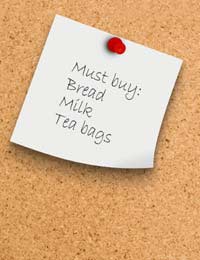Speech and Shopping Lists

Shopping lists may seem like one of life’s boring necessities, but when you are encouraging your child to expand his or her speech, language and literacy skills they can be invaluable tools for extra practice. The next time you need to make a list, involve your child in deciding what you need, writing out the list and then reading it with you as you shop. Through these everyday activities you will likely gain more insight into your child’s current skills, strengths and weaknesses and become better prepared to help him or her as needed.
Deciding List Entries
Deciding what you need to put on your shopping list can be an easy way to test and encourage your child’s speech and language skills. By involving him or her in this routine you can review your child’s:- Understanding of simple directions. (“Please see if we have salt.”)
- Understanding of complex directions. (“Count the apples and tell me if we have less than 10.”)
- Knowledge of items and names. (“Do we have dish soap?”)
- Knowledge of relative concepts and phrases. (“Are we running low on milk?”)
- Correct pronunciation of words. (“Yes, we do need SPA-ghetti.”)
- Correct grammar and sentence structure. (“That should be: ‘No, I don’t want ANYthing’.”)
Writing the List Together
Once you know what you need to add to your shopping list you can use the time spent writing these entries to carry out further checks on your child’s language skills. You can ask your child to write the list in order to analyse his or her ability to shape letters and words, or write the entries yourself while asking him or her related questions. Writing shopping lists is an excellent chance to measure your child’s understanding of:- Letters and sounds. (“What letter do you think ‘Ssssssalt’ starts with?”)
- Object relationships. (“Yes, salmon is a kind of fish. What other kinds of fish are there?”)
- Grouping of objects. (“Lets put all of the baking ingredients together.”)
- Reading. (“Why don’t we sound out the brand of flour we use?”)
Reading the List as You Shop
Don’t stop practicing when you’re finished writing your list. Take your child to the shop with you in order to practice reading, recognition and pronunciation skills. Let him or her:- Read or sound out the words on your list.
- Read or sound out words on advertisements or signs.
- Locate items in the shop based on signs.
- Ask for help from shop assistants.
- Practice letter matching. (“Yes, butter starts with ‘b’. What else starts with ‘b’ on our list?”)
- Match the word on the list to the item on the shelf or rack.
- Pronounce words on the list as well as brands when selecting items.
- Answer questions as you shop. (“What would you like for lunch tomorrow?”)
- Answer questions about items. (“Which brand of biscuits is on sale? How do you know that?”)
- Feel confident in their speech and language skills through praise or small rewards.
Related Articles in the 'At Home Activities' Category...
- Using Board Games to Encourage Speech
- Using the Internet in Speech Practice
- Speech Practice and Household Chores
- Including Siblings in Speech Practice
- Questionnaire: Do You Encourage Speech at Home?
- Encouraging Speech Through Charades
- Moving Beyond Baby Talk
- Nursery Songs and Speech
- Reading a Picture Book


Re: The Lidcombe Program
My 3 year old has started to stammer about 5 weeks ago and has progressed very fast and now it affect every word she pronounces and I am…
Re: Child Abuse and Speech Disorders
I stopped talking to my dad in my normal voice when I was in grade 1 after he hit me because I couldn’t understand my…
Re: New Earpiece to Help With Stammering
I am interested in being assessed for the use of the SpeechEasy hearing device and would be grateful if someone could…
Re: The Lidcombe Program
I don’t know what else to do ..
Re: New Earpiece to Help With Stammering
I have a Stammer and have always struggled with my speech and I think this would really help me and so many others.
Re: The Lidcombe Program
Sir I only stutter when speaking to others. Not when, I speak to myself can you tell me what's the problem.
Re: The Lidcombe Program
I am 23 years I am supering from stammer please how can I get vaccine for ti
Re: Expressive Language Disorder
I have a lot to ask . Please reach out. Thank you
Re: The Lidcombe Program
My age is 32...when IAM speaking difficulty to say word...IAM disappointed in my life only reason is stammring..plz help me...
Re: The Lidcombe Program
Is there any advice for a child who has been really forward with his speech since 2 he has stung sentences together so clearly. He has now…